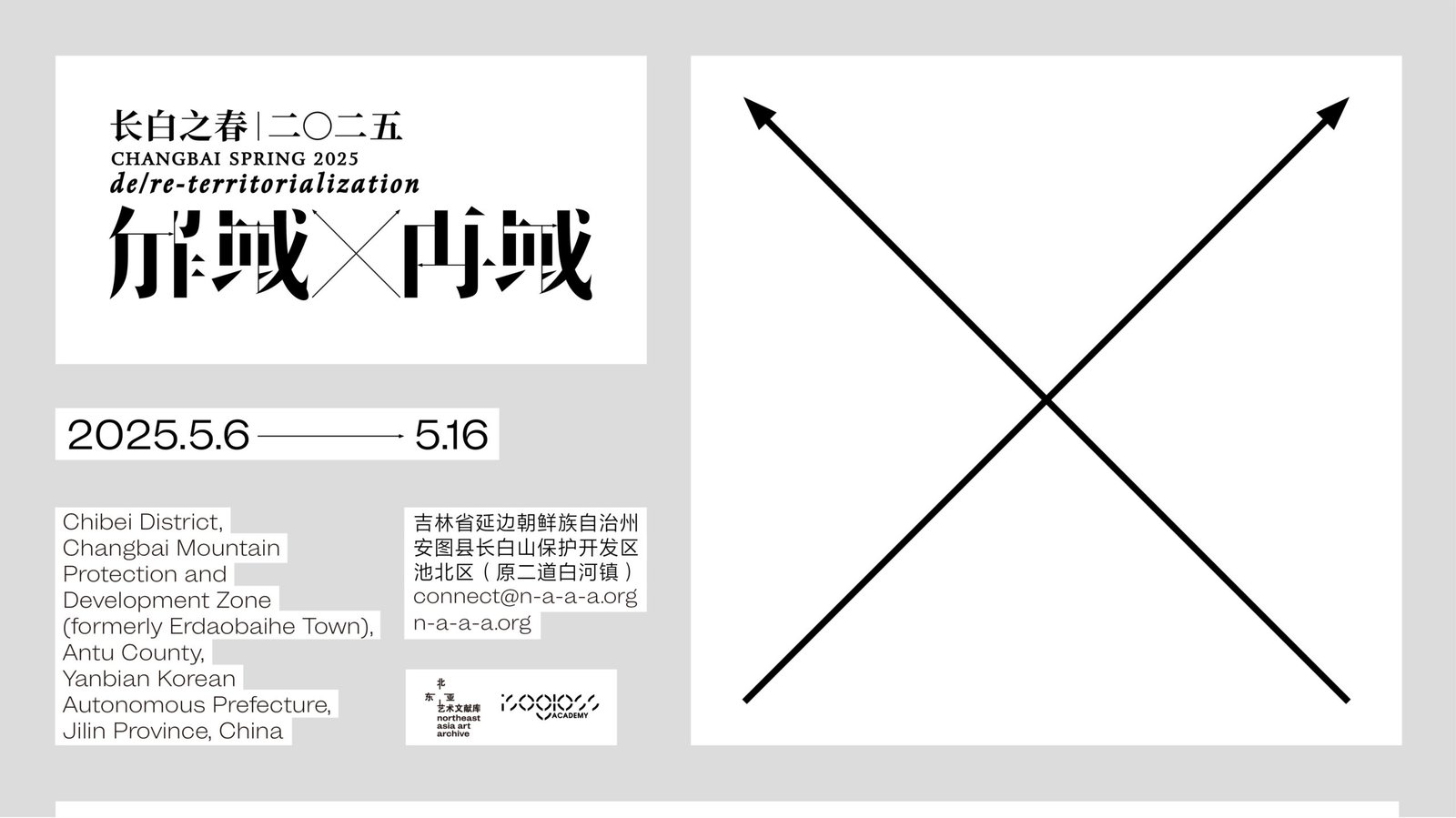May 6
–
May 16
CST
A Research Residency and Publication Project
Conceived by
Ou Ning and
Li Jiaqi
There is the twofold movement of decoding or deterritorializing flows on the one hand, and their violent and artificial reterritorialization on the other.
Gilles Deleuze and Félix Guattari,
Anti-Oedipus: Capitalism and Schizophrenia[1]
Changbai Mountain stands at the junction of China’s three northeastern provinces (Jilin, Liaoning and Heilongjiang) and the Ryanggang province in North Korea. Called Paektu Mountain in North Korea, it is like a white giant overlooking the vast territory of Northeast Asia. From the perspective of satellite imaging, Heaven Lake, which was formed by a volcanic eruption in the Quaternary about 2.6 million years ago, is like a deep dark eye, sending out “heavenly questions” to the creator. Over the long stretch of geological time, human beings hunted and gathered with the support of mountains, sowed and plowed fertile soil formed by volcanic ash, were nomadic over grasslands, filled their bellies with fish from rivers and the sea, and thrived on this land from generation to generation. They constructed their lives according to nature, creating customs and cultures through reliance on local conditions. Then, these people condensed into nations and states in order to claim land rights and political power and launched wars for the resources as well as the conquest of culture. These countless events were recorded to form a “history,” and this enculturation of historical barriers, coupled with long-term cultural immersion, has strengthened awareness of this land as its people’s own living territory, making it a unique human idiographic and geographical unit, a process of
territorialization.
Approaching human history from distant geological time, but also from recent times, territorialization can be seen as a continuous and repeated process. When Gilles Deleuze and Felix Guattari put forward the concepts of
deterritorialization and
reterritorialization for the first time in their philosophical work
Anti-Oedipus, they were criticizing late capitalism. Deterritorialization and reterritorialization can then be understood to be an almost simultaneous displacement of historical territorialization
, driving the operation of the capitalist desire machine and leading to schizophrenia. These two concepts were later applied, in historical anthropology, to the study of diasporic cultural adaptation. To adapt to local living conditions, immigrants will gradually give up the older familiar languages, customs, cultures and social relations, and acquire new ones. With the extension of settlement time, they will also produce new regional identities, that is, “after a long period, the foreign land will transform into their home.” This is the simultaneous process of deterritorialization and reterritorialization.
[2] However, with the rise of multiculturalism, these two concepts can face complex challenges when explaining diasporic phenomena.
Territorialization was developed as a concept in political geography to define national territory and Lebensraum.
[3] After Deleuze and Guattari first used the terms deterritorialization and reterritorialization, geographers continued to use them to construct a theory of regionalism. Especially after the practice of urban renewal arose, the concepts of deterritorialization and reterritorialization became powerful academic tools to analyze the redistribution of social resources by state power, and the dismantling and reorganization of social relations by real estate capital.
[4] The Changbai Spring research residency program,
de/re-territorialization, attempts to grapple with how to break through stereotypes of Northeast China and even Northeast Asia from the perspective of culture and art, and discuss concepts of cultural nativeness and locality, of this geographical region against the background of a globalization that has led to increased mobility and a double compression of time and space––to construct a new cultural subjectivity and regional identity.
The earliest geographical mapping of Changbai Mountain took place in 1709. Jesuit missionaries Jean Baptiste Regis, Pierre Jartoux and Xavier Fridelli, appointed by the Kangxi Emperor, were the first Europeans to set foot on Changbai Mountain.
[5] Their latitudinal and longitudinal maps were included in the woodcut
Kangxi Imperial Atlas of China in 1717, which can be said to be the Qing empire’s own record of territorialization. Changbai Mountain stretches for more than 8,000 square kilometers, with the main vein shared by Jilin Province and Ryanggang Province, the remaining veins continuing on to Liaoning Province, Heilongjiang Province and the Korean peninsula. It is the birthplace of the Songhua River, the Yalu River and the Tumen River. Its nourishing culture has also flowed from the core area to Liaoning and Heilongjiang, the Korean peninsula, eastern Inner Mongolia and even to the far east of Russia, forming a ripple-like circle. It is not only a landmark of Northeast Asia, but also a sample of the cultural ecology of the region.
Northeast Asia, as the birthplace of both the (Mongol) Yuan empire that conquered Eurasia and the Qing regime that entered the Central Plains, as well as where Japan developed the colony of Manchukuo, has always been of concern to historians. The territories of China, North Korea, Japan, Russia and Mongolia are also regarded as important points from which to observe geopolitical activity. However, academic research has long focused on the political and economic dimensions of Northeast Asia, and little attention has been paid to the interactive practices of its ecologies, cultures, arts, and multiple ethnic communities. The Changbai Spring project is intended to fill this gap. The residency is located in the settlement of historically Korean immigrants in Jilin Province, China. It is also close to the locus of Heaven Lake. The project will focus on field investigations and research, but its attention will cover northeast China and the whole of Northeast Asia. In spring, the invited artists and scholars with Northeast Asian backgrounds and the signed-up research fellows will gather at the banks of Heaven Lake to discuss the big questions: Why am I here? What do I bring to humanity? What has humanity brought me?
Invited Guests
Irina Botea Bucan and Jon Dean (US/GB), artist, professor at School of the Art Institute of Chicago
Colin Siyuan Chinnery (CN/GB), sound artist, founder of Sound Art Museum, Beijing
Yuan Fuca (CN/US), curator
Geng Jun (CN), filmmaker
Gu Tao (CN), filmmaker
He Ping (CN), literary critic, professor at Nanjing Normal University
Liang Chen (CN), architect and artist
Liu Chuanhong (CN), artist
Liu Yan (CN), scholar of cultural studies
Michael Meyer (US), professor of English at the University of Pittsburgh, author of
In Manchuria: A Village Called Wasteland and the Transformation of Rural China
Aki Onda (JP/US), composer, sound artist
JeongWon Bourdais Park (KR/GB), associate professor at University of Nottingham, Ningbo
Kyong Park (KR/US), founder of Storefront for Art and Architecture, New York; professor of University of California San Diego
Jeongkil Park (CN), local zoologists and wildlife biologist
Hankil Ryu (KR), musician, sound artist
Song Nianshen (CN), historian at Tsinghua University
Sun Haiting (CN), photographer
Jeremy Tiang (SG/US), writer, translator, and playwright
Wang Tuo (CN), artist
Brian Kuan Wood (US), co-founder of e-flux, editor of
e-flux Journal
Yan Jun (CN), musician, poet
Yang Zhihan (CN), fiction writer
Mia Yu (CN), artist and curator
Zeng Han (CN), photographer and artist
Zhang Meng (CN), filmmaker, director of
The Piano in a Factory
Zhang Wenzhi (CN), artist
Zhang Xianmin (CN), professor of Beijing Film Academy
Zhang Xiao (CN), photographer and artist
Zhou Haicheng (CN), local botanist
Agenda
May 6 Tuesday, 2025
Introduction
Arrival, Welcome Dinner
May 7 Wednesday, 2025
Field Trip
Natural Habitat of Changbai Mountain: The Memetics of Biodiversity
Zhou Haicheng, Jeongkil Park
May 8 Thursday, 2025
Field Trip
Past and Present of Gando: Diasporization and Identification
JeongWon Bourdais Park
Visiting Yanbian Mueum in Yanji and a Joseonjok village in Longjing
May 9 Friday, 2025
Seminar
Pictorial Dongbei: Archiving and Dearchiving
Sun Haiting, Zeng Han, Zhang Xiao
Performance and Seminar
Phonographic Yanbian: Field Recording and Sound Making
Colin Siyuan Chinnery, Aki Onda, Ou Ning, Hankil Ryu, Yan Jun
May 10 Saturday, 2025
Seminar
Dongbei Renaissance: New Arts of Storytelling
He Ping, Michael Meyer, Jeremy Tiang, Yang Zhihan
Seminar
The Historical Gaze and Rewritings on Northeast Asia
Liang Chen, Liu Yan, Mia Yu, Song Nianshen
May 11 Sunday, 2025
Seminar
The Immortal and Mortal Coils: Shaman and Mythorealism
Geng Jun, Gu Tao, Zhang Meng, Zhang Xianmin
May 12 Monday, 2025
Seminar
The Local Turn: From Globalization to Glocalisation
Irina Adina Bucan+Jon Dean, Kyong Park, Brian Kuan Wood
Seminar
The Contemporary Vernacular Practices: Arts and Regionism
Yuan Fuca, Liu Chuanhong, Wang Tuo, Zhang Wenzhi
May 13 Tuesday, 2025
Group Presentations
by signed-up research fellows
Field Trip
Manchurian Utopia: The Historical Architecture of Ultra-Modernism
Harbin
May 14 Wednesday, 2025
Field Trip
Manchurian Utopia: The Historical Architecture of Ultra-Modernism
Hsinking (Changchun)
May 15 Thursday, 2025
Field Trip
Manchurian Utopia: The Historical Architecture of Ultra-Modernism
Dairen (Dalian)
May 16 Friday, 2025
Field Trip
Journey to the Borderland
Antung (Dandong)
Conclusion
Farewell Dinner
August 16, 2025
de/re–territorialization exhibition opening (Yanbian)
October 18, 2025
Northeast Asia Art Archive New York opening
de/re-territorialization exhibition and events (New York)
April 18, 2026
de/re–territorialization publication launch in the next edition of
Changbai Spring (2026)
________________
[1] Gilles Deleuze and Félix Guattari,
Capitalisme et schizophrénie l’anti-œdipe (Les Éditions de Minuit, 1972).
Anti-Oedipus: Capitalism and Schizophrenia (University of Minnesota Press, 1983), translated by Robert Hurley and Mark Seem.
[2] Michael Szonyi used these two concepts to analyze the “everyday politics” of military households who were recruited to be stationed in different places when studying the implementation of the military system in China in the Ming Dynasty. See Michael Szonyi,
The Art of Being Governed: Everyday Politics in Late Imperial China (Princeton: Princeton University Press, 2017).
[3] German geographer Friedrich Ratzel first put forward the concept of
territory in his book
Political Geography (1897), and American geographer Thomas Sauer enriched the discussion of
territoriality on this basis. See Thomas Sauer,
Human Territoriality: Its Theory and History (Cambridge: Cambridge University Press, 1986).
[4] John Harrison, “Networks of Connectivity, Territorial Fragmentation, Uneven Development: The New Politics of City-regionalism”,
Political Geography, Volume 29, Issue 1, January 2010, Pages 17-27.
[5] Henry Evan Murchison James,
The Long White Mountain; Or A Journey in Manchuria: With Some Account of the History, People, Administration and Religion of that Country (London: Longmans, Green, and Co., 1888), Pages 265-266.


